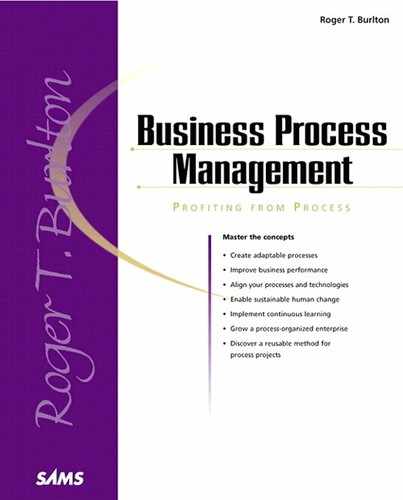Confirming Scope and Boundaries
This step will challenge and confirm the scope developed in the Vision phase (see Chapter 12, “Charting the Course of Change”) or create it if it hasn’t yet been produced. In this step, the organization defines the boundary definitions of the process, including constraints and interprocess relationships, thereby providing controls for the analysis of the work to be conducted by the team. It is critical to confirm scope and boundaries if time has gone by since approval of the Vision phase scope approval or if new players are involved.
Techniques
The techniques used to create or validate the scope from the previous phase include
Scope modeling
Workshop facilitation
Lessons Learned
If a scope has been set in the Vision phase, the effort here might prove to be incidental and more of a formality. If not, the following cautions and guidelines should be taken seriously. In the best case, the scope should be examined for continued validity. This is especially true if new management and/or new project team leaders have been appointed since the original scope was conducted.
Scoping will start with the Process Architecture diagram and descriptions produced in the Architect and Align phase (see Chapter 11, “Configuring Business Processes and Aligning Other Strategies”). However, the scope of the project might not coincide exactly with earlier diagrams. The project might cover more than one related process or only a portion of one, or it might cover the entire process but only for certain customer segments, products, or locations. As mentioned earlier, this step is optional in this Understand phase if it has been adequately covered in the Vision phase and there has been little time for the business requirement to change. Validate it as a safety check.
Commonly, the process scope will be closely aligned to interface points with other feeding or receiving processes. Examine all interfaces in and out and ask whether the incoming interfaces are inadequate; also check out processes that feed the in-scope process. Ask whether the receiving process gets good results and optimizes the use of what it receives. Include those interfaces that can be accommodated without risking the project. Exclude the interfaces that don’t make too great a difference or those that can’t be handled right now politically.
The results of this step must be accepted by management, especially business management, because they will live with the solution, like it or not.
Scope determination isn’t an exact science. Judgment is a key asset. Get some political support from the process champion at this point.
Document and draw pictures of what’s in and especially list what’s out. Present this and get consensus before starting analysis. You will be sorry if you don’t.
Remember to include other aspects of scope such as locations, information types, organizational units, products, transactions, and so on.
Distinguish among scope of analysis, which can be greater than the scope of design and implementation. The project should be aware of its fit with other areas of the business even if it does not change them. Remind everyone that scope might change at later checkpoints as you learn more. In many cases, it might be necessary to study a wider range of characteristics than planned for initial rollout because later the solution might have to be broadened and must work when it is.
Use the scope definition for project management purposes. You will be thankful if you do. It will allow you to assure the management team’s commitments and to keep your project analysts from being the cause or victim of creeping or shrinking scope change and analysis paralysis.
Make sure that all team members are intimately familiar with the scope and rationale for how decisions were made. Make it a capital offense for staff to model and analyze outside scope without an acceptor and champion’s formal acceptance of the impact on the project. This means changes to time, cost, and resources must be agreed to and committed to first.
Focus on triggering events and outcomes to force an outside-in perspective that concentrates on boundaries.
Define all terms used to ensure a true understanding of what’s being said. Saying that something is “in scope” can lead many people to infer completely different understandings that otherwise will only come to light much later.
